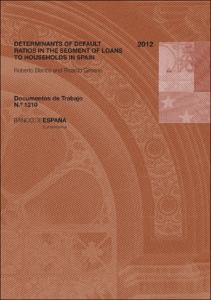Determinants of default ratios in the segment of loans to households in Spain
Autor
Fecha de publicación
17-feb-2012
Descripción física
38 p. : tab., gráf.
Resumen
In this paper we present the estimation results of a dynamic panel data model that explains the dynamic behaviour of default ratios in Spain for loans extended to the household sector. We estimate the models for two alternative definitions of default and for two different loan categories. The dataset consists of a panel of 50 provinces and covers the period 1984-2009. The results of the models show that the dynamic behaviour of the default ratios of loans extended to Spanish households can be reasonably well characterised with the lagged LHS variable, and the contemporaneous and the lagged values of credit growth, the unemployment rate and the interest debt burden. We find that the increase in the unemployment rate was the main driver of the sharp rise in default ratios between 2007 and 2009 in Spain and that the fall in interest rates since the end of 2008 contributed to moderating the upward path of default ratios in 2009. We also find that there is strong evidence of asymmetrical effects of unemployment ratios on default ratios, and differences between banks and savings banks in their sensitivity to the cycle
En este artículo se presentan los resultados de estimar modelos dinámicos de datos de panel, que explican la evolución dinámica de los ratios de morosidad de los créditos a los hogares en España. Estimamos modelos separados para dos definiciones distintas de morosidad y para dos segmentos de créditos diferentes. La muestra está constituida por un panel de las 50 provincias a lo largo del período 1984-2009. Los resultados de estos modelos muestran que el comportamiento dinámico de los ratios de morosidad se puede describir a partir de esa misma variable desfasada, y los valores contemporáneos y retardados del crecimiento del crédito, de la tasa de paro y de la carga financiera por intereses. Encontramos que los incrementos del desempleo han sido los principales responsables del fuerte aumento de las ratios de morosidad entre 2007 y 2009 en España y que la caída de los tipos de interés desde finales de 2008 ha contribuido a moderar en 2009 esa tendencia creciente. También encontramos fuerte evidencia de los efectos asimétricos de la tasa de paro sobre la morosidad, así como diferencias en la sensibilidad al ciclo entre los créditos concedidos por bancos y cajas de ahorros
En este artículo se presentan los resultados de estimar modelos dinámicos de datos de panel, que explican la evolución dinámica de los ratios de morosidad de los créditos a los hogares en España. Estimamos modelos separados para dos definiciones distintas de morosidad y para dos segmentos de créditos diferentes. La muestra está constituida por un panel de las 50 provincias a lo largo del período 1984-2009. Los resultados de estos modelos muestran que el comportamiento dinámico de los ratios de morosidad se puede describir a partir de esa misma variable desfasada, y los valores contemporáneos y retardados del crecimiento del crédito, de la tasa de paro y de la carga financiera por intereses. Encontramos que los incrementos del desempleo han sido los principales responsables del fuerte aumento de las ratios de morosidad entre 2007 y 2009 en España y que la caída de los tipos de interés desde finales de 2008 ha contribuido a moderar en 2009 esa tendencia creciente. También encontramos fuerte evidencia de los efectos asimétricos de la tasa de paro sobre la morosidad, así como diferencias en la sensibilidad al ciclo entre los créditos concedidos por bancos y cajas de ahorros
Publicado en
Documentos de Trabajo / Banco de España, 1210
Materias
Default ratios; Non-performing loans; Household finances; Financial pressure; Ratios de morosidad; Créditos dudosos; Posición financiera de las familias; Presión financiera; Modelos de datos de panel; Créditos; España
Aparece en las colecciones:












